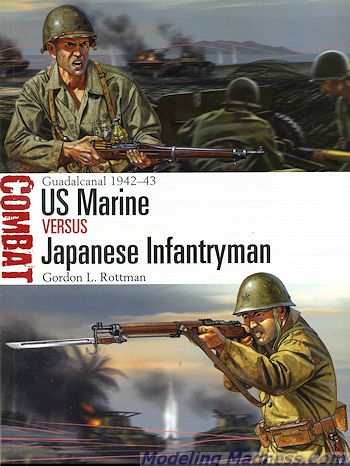 The next
title in Osprey's 'Combat' series is this one which compares American Marines
and Japanese Army Infantry during the Guadalcanl campaign of August 1942 to
February 1943.
The next
title in Osprey's 'Combat' series is this one which compares American Marines
and Japanese Army Infantry during the Guadalcanl campaign of August 1942 to
February 1943. Osprey's US Marine vs Japanese Infantry
|
Author: |
Gordon Rottman |
|
Publisher |
Osprey |
|
Price |
$18.95 MSRP |
|
Reviewer: |
|
| Notes: |
80 pages, 7¼ x 9¼
inches, softbound ISBN: 978-1-4728-0134-0 |
 The next
title in Osprey's 'Combat' series is this one which compares American Marines
and Japanese Army Infantry during the Guadalcanl campaign of August 1942 to
February 1943.
The next
title in Osprey's 'Combat' series is this one which compares American Marines
and Japanese Army Infantry during the Guadalcanl campaign of August 1942 to
February 1943.
At this point in time, the two sides were quite different in their attitudes towards war. The Americans had never been in combat, though they had been training for months and had acclimated themselves somewhat to the the sort of climate they would face on Guadalcanal. The Japanese, on the other hand, had combat veterans of the war in China, Singapore, Java and the Philippines to name a few places. Here they were not faced with a strong and determined enemy and certainly had little experience fighing in the sort of humid jungles they would face on Guadalcanal.
Those few troops that were on Guadalcanal were totally surprised by the landing and so fled to the north. There were no defensive positions prepared around the airfield nor was there anything more than light weapons available to the small naval landing force that was there along with several thousands construction workers.
It was not until over a week after the US landings that the Japanese started sending in troops to try to take back the airfield. Had they sent in troops immediately after the Marines came ashore, things might have been different, but throughout the campaign, the Japanese reinforced at a piece-meal rate so never really had the strength needed for a successful assault.
There were several reasons why the Japanese failed in Guadalcanal. One was a lack of proper weapons. In all categories, the Marines has more reliable and more powerful arms. Secondly was a lack of flexibility. They performed the same sort of attack after an initial assault failed. They were committed to a set tactic where they assumed many things about the enemy and when the enemy did not do as expected, their plans fell apart. They also believed that their 'superior' will to fight would win the day, when that was not at all the case. All of these were situations that were prevalent throughout the war as it seemed the Japanese were simply unable or unwilling to learn from past events.
In this book, we look at the background, training and tactics of both sides at this time. We see the strengths and weaknesses of both sides and get a chance to read about the progress of the fight and how the soldiers on both side fought during the battles. It is this look into the make-up of the two armies and how they put their training to work that really is the heart of this series. We learn from their actions what worked well and what did not. We see what these men went through and how the battles affected them and their comrades. The book covers three major actions during the campaign; the battle of Tenaru in August, an attack on the airfield in September and the Matanikau counteroffensive, one of the few times Japanese tanks were used on Guadalcanal.
The book is superbly written and has some very compelling period photos and superb art work that only enhance what is a well done book. It is a book that draws in the reader and gives him a sense of what it was like. A book I fully enjoyed reading and can quite easily recommend to you.
October 2014
For more on the complete line of Osprey books, visit http://ospreygrp.com. In the US, it is Osprey Direct at 443 Park Avenue South, New York, NY 10016, where you can get a catalogue of available books.
If you would like your product reviewed fairly and fairly quickly, please contact the editor or see other details in the Note to Contributors.